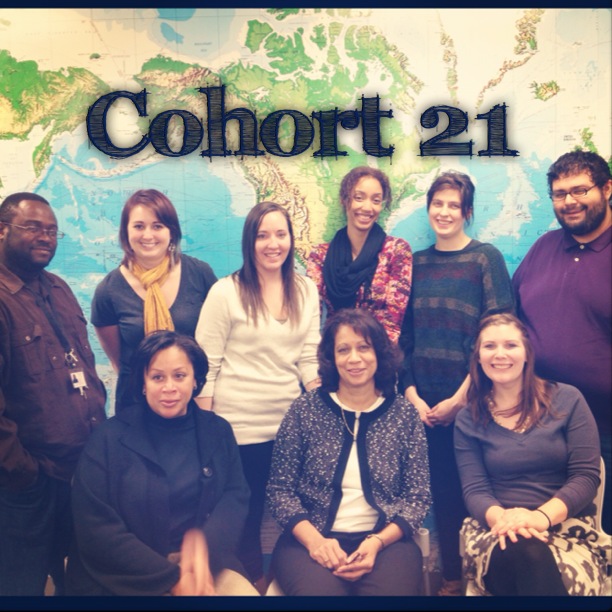
Getting to Know Your Cohort
[flickr id=”8268969004″ thumbnail=”medium” overlay=”true” size=”original” group=”” align=”none”]
For the past 15 weeks, my cohort has taken our Methods of Math course with the first-year cohort. At first, I wasn’t sure how it was going to work. I imagined a curriculum that was slowed down to accommodate the first-years. I imagined lots of time spent having to explain ideas that I’d already grasped. My imagination was definitely in overdrive. What I found, though, was that it was a very meaningful experience for both myself and the rest of the class.
Our professor, Ava, is truly awesome. She did not slow down the curriculum, but rather she expected that the second-year students act at times as peer teachers. It is true, after all, that the best way to truly understand a concept is to teach it to someone else. Guys, this is the first time I can honestly say that I LOVED a math course that I’ve taken. What a cool feeling.
In addition to the Methods of Math course, the first years were also taking a Math Technology course. (We had ours this summer.) Ava and the cohort invited us to come to their final presentations to see what they had been working on. It was a great night of investigation, play, and discovery! And, it was also truly delightful to see the first-year students on their own and in their element—in essence, really shining.
[flickr id=”8267912983″ thumbnail=”medium” overlay=”true” size=”original” group=”” align=”none”]
The presentations started with Ashley and Annie, who showed us how to use Active Vote to enhance a lesson plan. ActiVote syncs with Active Inspire, a system similar to Power Point (but more more interactive) for a classroom Promethean Board. Students are given remotes that allow them to respond to questions throughout the presentation. Their answers are tallied in real time and can be displayed in various graphs on the Promethean Board.
Annie and Ashley walked us through a presentation on how to plant flowers, with a quiz at the end that related to the lesson. The ability to weigh in and see my answers on the board instantly increased my engagement in the activity. They showed a good amount of ease with the system itself and also expressed interest in using the program again in the spring so they would be ready to approach it in their own classrooms. Nothing like actually getting practice to use something that could potentially feel so daunting in the real world!
[flickr id=”8267911773″ thumbnail=”medium” overlay=”true” size=”original” group=”” align=”none”]
Nichelle and Christine also used Active Inspire for their presentation on Geometry and Dance. In addition to working like a Power Point system, Active Inspire gives students the ability to write on the board with a stylus, move images around the screen, and use math tools to take accurate measurements.
Nichelle and Christine displayed various angles on the board and had classmates volunteer to use different tools to measure the degrees. We then all showed different ways we could make the angles with our bodies, and they taught us dance moves that resembled the angles! It was an extremely interactive and arts integrated lesson. I especially loved that students would be simultaneously interacting with the board, moving their bodies, learning new terminology, and solving math problems. Columbia is all about arts integration, and these two really showcased their understanding of how to do it with their presentation.
[flickr id=”8267906675″ thumbnail=”medium” overlay=”true” size=”original” group=”” align=”none”]
Eliza and TJ presented a lesson that focused on proportional reasoning. Their use of Active Inspire involved creating their own math problems with images that could be manipulated by the students to solve the problems. Their lesson involved a lot of classmate participation, and the time they spent working with grouping images was very impressive. It seemed like they had a really awesome grasp of how to create visual word problems, and it was fun to watch students alternate between writing out numbers with the stylus and actually moving the pieces around to figure out the proportions. Their lesson also included a showcase of a tool within Active Inspire that recognizes shapes as students draw and helps form the lines so they are more accurate drawings. It even does this for handwriting, hence the very lovely Beyonce Triangle!
[flickr id=”8268971418″ thumbnail=”medium” overlay=”true” size=”original” group=”” align=”none”]
Andrew and Antonio rounded out the presentations with a lesson on the effects technology has on sleep. Their math subject was statistics, and I LOVED how they related that to a subject that graduate students consider so important. They first used Active Inspire like a Power Point presentation with very lovely slides, but they also included several survey questions for us to complete as we went through about our own sleep and technology habits. We learned that as we vote we can also be assigned a remote so that the class can see my specific answer! This would be especially useful for a teacher as they could print out classroom results and use it as an assessment. Andrew and Antonio created clever math problems revolving around work and sleep that could all be solved using fractions. It was both meaningful and relative to my work and my own life. Overall, an excellent end-cap to the technology presentations.
[flickr id=”8267903109″ thumbnail=”medium” overlay=”true” size=”original” group=”” align=”none”]
Cohort 21, y’all seriously rock! Thank you for teaching me how to utilize a Promethean Board in my own classroom. I can’t wait to get my hands on the technology!
